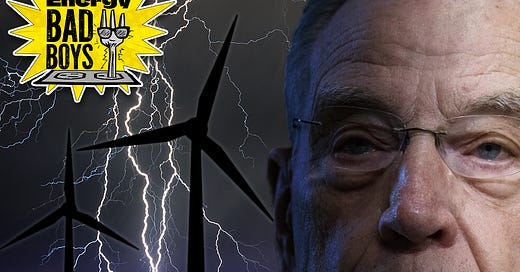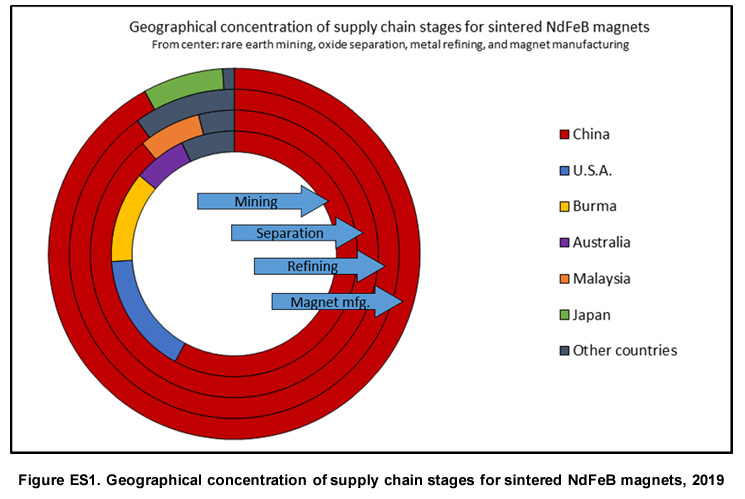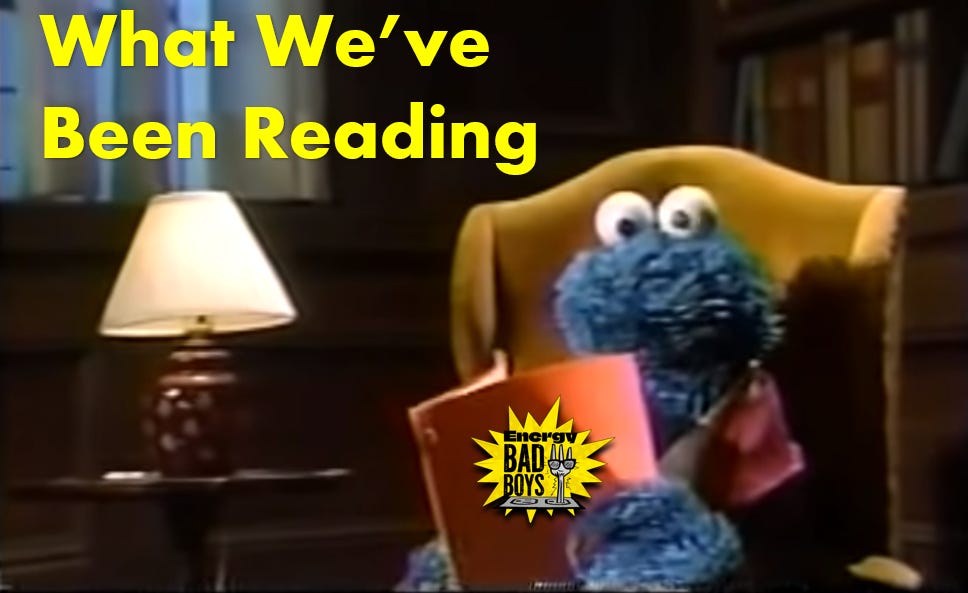Grassley v. The Grid
Wind subsidies are undermining grid reliability, increasing costs, and making the U.S. more dependent on China for its energy. It's time to put them out to pasture.
“We get a tax credit if we build a lot of wind farms. That's the only reason to build them. They don't make sense without the tax credit.” - Warren Buffett
Energy policy is often portrayed as a matter of left vs. right, where Democrats champion wind, solar, and battery storage while Republicans support coal, oil, natural gas, and, increasingly, nuclear power. If only it were that simple.
Last week, Senator Chuck Grassley (R-IA) took to the pages of the Des Moines Register to tout the success that the wind Production Tax Credit (PTC) – a federal subsidy for wind energy he first championed 30 years ago – has had in stimulating wind development in Iowa.
Unfortunately, Sen. Grassley, who is known as the “Father of American wind energy, ” does not appear to appreciate that times have changed and that while these subsidies have grown Iowa's wind industry, they have also become an existential threat to the reliability of the grid, raised electricity costs for all Americans, including Iowans, and undermined our national security.
For these reasons, Senator Grassley and other conservative members of Congress who have voted for the PTC in the past must put this subsidy out to pasture as quickly as possible. If they fail to do so, America will face serious consequences.
What is the Wind Production Tax Credit?
The PTC is a per kilowatt-hour (kWh) federal tax credit included under Section 45 of the U.S. tax code for electricity generated by qualified renewable energy resources, and it is worth 2.75 cents per kWh, or $27.50 per megawatt-hour (MWh), for the first ten years of a wind project’s life. Companies can also “repower” their wind operations to requalify for the PTC after only ten years, which we detailed in our piece, The Death of a Wind Farm.
Senator Grassley has stated that the wind subsidies were never meant to be permanent, and the original purpose of the tax credit was to act as a temporary “jump-start” to the fledgling wind industry, which at that time was still struggling to get off the ground.
But, as Milton Friedman quipped, “Nothing is so permanent as a temporary government program.” The PTC has been extended at least 14 times, often retroactively, since it was first enacted in 1992 as part of the Energy Policy Act of 1992. Many of these reauthorizations were part of legislation that was unrelated to energy.
For example, according to a Congressional Research Service report, the PTC was extended in 1999 as part of the Ticket to Work and Work Incentives Improvement Act, in December 2003 as part of the Job Creation and Worker Assistance Act, in 2004 as part of the Working Families Tax Relief Act of 2004. This list continues, suggesting that Mr. Grassley’s subsidy has been viewed as an innocuous rider attached to many bigger bills regardless of who occupies the White House.
The most recent reauthorization of the PTC is also its most dangerous one. In 2022, Democrats passed the so-called Inflation Reduction Act (IRA) on a party-line vote to extend the PTC and a whole host of other “green” subsidies out to 2032.
Headline numbers suggest these subsidies cost more than $1.2 trillion, but our friend friend and honorary Energy Bad Boy
argues that unless repealed, the energy subsidies in the IRA are permanent, only expiring when specified emissions targets are met. This could mean that some provisions will last well beyond the 10-year budget window.With the help of the PTC and state renewable energy mandates, wind capacity in the US has grown to more than 140 gigawatts as of 2022 – representing more than 12 percent of all the installed capacity in the country. Needless to say, the industry is no longer in a state of adolescence; it is large enough to undermine the reliability of the grid.
Undermining Reliability
The North American Electric Reliability Corporation (NERC) warns that the Midcontinent Independent System Operator (MISO), a 15-state regional electric grid that includes Senator Grassley’s home state of Iowa, is at the largest risk of rolling blackouts in the country, which you can see in the graph below.
The situation in MISO is already dire because it’s becoming overly dependent upon unreliable wind and solar generators and shutting down too many coal and natural gas plants. NERC’s report notes that “beginning in 2028, MISO is projected to have a 4.7 GW shortfall if expected generator retirements occur despite the addition of new resources that total over 12 GW.”
As foreboding as NERC’s figures may seem, they are conservative because they do not account for any of the EPA regulations designed to force the premature retirement of reliable power plants that the wind PTC is enabling.
Enabling Biden’s EPA Overreach
Perhaps the worst aspect of the PTC is that it, and other subsidies, are enabling President Biden's Environmental Protection Agency (EPA) extreme regulatory agenda that will cause massive rolling blackouts in the region.
EPA is pretending that its regulations on carbon dioxide emissions from power plants won't be expensive because the subsidies for wind and solar in the Inflation Reduction Act (IRA) make them so cheap that there will be a massive shift away from reliable coal, natural gas, and nuclear plants toward wind and solar facilities.
In its Regulatory Impact Analysis, a long document that is supposed to justify new regulations, the EPA claims that the IRA subsidies will be responsible for 99 percent of the changes in resource mix on the MISO system in the future, while only the last 1 percent will be due to the agency’s carbon dioxide regulations.
As a result, coal will almost entirely be phased out by 2035 and will be largely replaced with wind and solar power with some natural gas. The subsidies allow EPA to mislead the public about the true impact of the regulations and the cost to consumers.
American Experiment's modeling of these regulations found that EPA's carbon rule would cause massive rolling blackouts, large enough to plunge the entire state of Iowa and Minnesota into darkness at the same time. We detail the impact of the carbon rule in our Substack post, “Enjoy the blackouts, Jack.”
The country cannot continue to give the Biden Administration the ammunition they need to assault the reliability of the electric grid, but the wind subsidies do precisely that.
Negative Wholesale Prices
Not only do the wind subsidies enable the worst excesses of the EPA, they also deprive reliable coal, nuclear, and natural gas generators of the revenue they need to remain in operation and can cause electricity prices to go negative because the PTC pays wind projects $27.50 for each MWh of electricity the facility produces, whether or not that electricity is needed.
The subsidies mean that electricity generated from wind farms could potentially be sold into the market at a price of negative $27.49 per MWh and still turn a profit for their owners. This is why the areas with the most wind turbines see the most negative prices, which you can see in the map below.
When prices are negative, coal and nuclear plants are forced to pay other people to take their power because it is difficult for them to scale back their generation quickly. In vertically integrated markets or regional transmission organizations (RTOs) with capacity markets, this generally means higher prices for families and businesses, but in “energy only” markets like the Electric Reliability Council of Texas (ERCOT), these plants exit the market entirely, leaving the grid increasingly vulnerable to blackouts.
Driving Up Costs
The wind subsidies have also incentivized companies throughout the United States to invest in the technology, which is causing electricity prices to skyrocket at great expense to families and businesses. In fact, all-sectors electricity rates reached new all-time highs in 2022 and 2023.
As we detailed in our piece, “Electricity Prices Are Soaring: It’s Time to Hold the “Energy Transition” Accountable,” the massive price increases Americans are enduring are largely due to utilities spending tens of billions of dollars on wind turbines and solar panels.
Even Iowa families have been hurt by this subsidy-induced malinvestment.
For example, Alliant Energy increased its electricity costs by $240 per year in 2020 to pay for wind turbines, and it is now asking to force customers to pay an additional $120 in 2024 and $84 in 2025, meaning costs for Iowa families have increased by at least $444 in the last four years. These additional costs are hard to stomach at a time when many are already struggling to keep up with inflation.
Continuing to subsidize wind (and solar) will lead to higher penetrations of these resources on the market, but because wind frequently disappears for significant periods of time, this additional capacity is an added expense to a grid that would work just fine without it. As a result, we all pay more for power.
National Security
In his op-ed, Senator Grassley wrote, "The U.S. must relentlessly pursue all-the-above solutions that shrink our dependence on foreign producers, particularly our adversaries." The Energy Bad Boys agree. However, while energy independence through wind energy was likely one of the original goals of the PTC, this goal has not come to fruition.
In fact, building wind turbines weakens our energy and national security because it makes us more dependent on China. Unfortunately, China utterly dominates the supply chain for the rare earth magnets that are an indispensable ingredient in wind turbines, refining 90 percent of the world's rare earth metals and manufacturing 92 percent of rare earth magnets.
This puts America at a greater geopolitical risk because China is more than happy to ban exports of rare earth magnet technology to achieve its political ends. This is exactly what Russia did when they exploited Europe’s dependence on Russian natural gas to wage war on Ukraine. America must not make the same mistake regarding Chinese wind and solar technology.
Put the PTC Out To Pasture
We all understand that good intentions can lead to bad policy endpoints.
The original goal of the PTC was to kick-start the wind industry, ideally so that it could survive on its own without handouts from the government. However, as a mature market, the wind industry is still largely reliant on PTC subsidies more than 30 years after its original passage, which is why it fights so hard to extend them whenever the deadline approaches.
This self-dealing is understandable for the wind industry, but Republicans in Congress can no longer ignore the harmful impacts that the wind production tax credit is having on America by making our grid more vulnerable to blackouts, increasing electricity costs for Iowans and Americans in general, and making the United States more dependent on China.
For the sake of the country, it is time for Senator Grassley and other Republicans to finally put the PTC out to pasture by repealing the subsidies in the IRA at their first opportunity.
Click Like, Share, and Subscribe for more Energy Bad Boys Content!
Here’s what we’ve been reading this week.
The Deindustrialization Of Europe In Five Charts by
State officials blame federal regulation for higher energy prices: ‘Customers are getting hurt by Utility Dive













Great piece. Aside from the economics, a renewable-heavy grid faces significant challenges maintaining a 60hz frequency, something that also can cause blackouts or massive equipment damage if it gets out of line. I can’t find it this morning, but there’s a good piece about how Denmark has to run its nat gas fleet flat-out and dump power in the wholesale market when its actual demand is theoretically met by wind for this reason.
Let’s not forget ethanol subsidies while we focus on tax credits and the great state of Iowa. Beyond the PTC’s there were/are ITC’s or Investment Tax Credits, and tax equity that Private Equity and developers with a dream they want to share with us, and who oddly have no money of their own to build the dream, use to “make” a proposed wind project work. If one considers the parfait of financing that goes into an energy generating project, wind and solar are just the worst tasting parfait mix of risk financing anyone has ever come up with, until one puts the full faith and credit of the American taxpayer behind it. Personal experience in the financing and construction of large utility scale wind projects to the detriment of gas, hydro, biomass generating projects in a large portfolio, it was frustrating to watch those projects go wanting for major maintenance and other operational requirements, whilst wind got a kiss on the top of its head every morning, especially after the wind blew like stink all night and then died in the morning. Exactly, prices went negative over night and then recovered during the day, but the 24 hour cycle tended to put non wind generation in negative results over the fullness of time. Sadly, the arcane nature of the rules that govern generation, transmission and distribution of electricity in the lower 48, are meant to absolutely confuse and obfuscate the rather simple process of generating a kilowatt and selling it at a profit. No doubt if you asked Senator Grassley (a nice enough old fellow at age 90, now the oldest sitting senator in the US Senate….) how grid actually works his answer would come with a grin as he walked to the switch on the wall in his senate offices and flipped it to the “up or on” position. “What’s not to like there young fella? Corn dog with corn syrup binder for a snack?” And of course wind in Iowa helped make it happen. This grift continues until the majority in MISO are so tragically affected in the winter or hot summer months when the circuits are all open, that they are dying in the extreme cold or heat. If it is so, as California goes, so goes the rest the country, then grand times are ahead for the consumers of regulated utilities supplied electricity for all. As a New Englander, we can’t throw stones, our leadership determined years ago that despite the fact we are nearly wholly dependent on natural gas supply to run the NEISO grid, building new pipelines to supply said gas, is out of the question. Our turn at blackouts is coming. But never fear! Johnny “live shot” Kerry has plenty of stand by propane generation at the Forbes family retreat on Naushon Island, in case things get sticky at his estate on Martha’s Vineyard, it’s a quick 3 mile evacuation route across Vineyard Sound. But of course we can rely on the good will of our French speaking neighbors to the north and Hydro Quebec to supply what we don’t have on hand at low and fair prices. Besides “Live Shot” Kerry is fluent in the French language so he can translate and negotiate on our behalf.
No one pays until the bill comes due, then the least able are asked to pay.